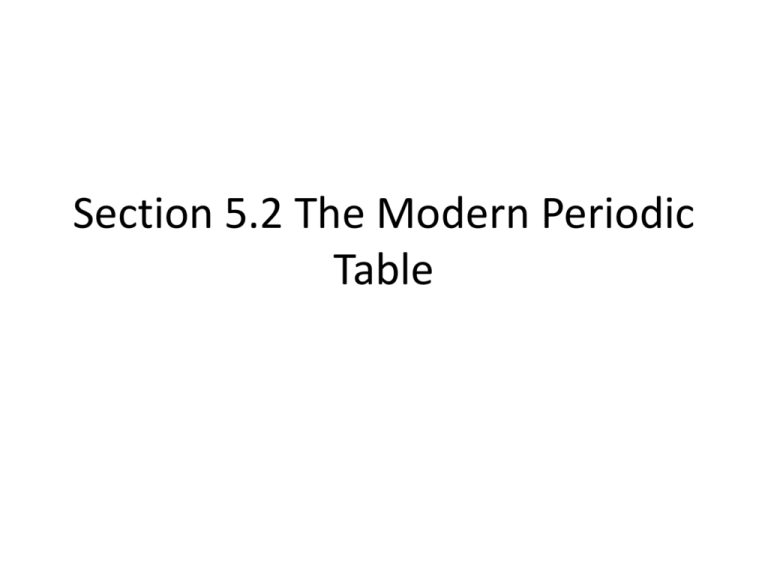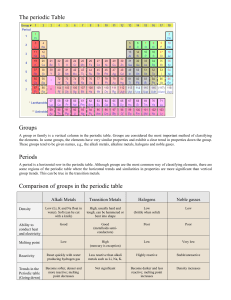Modern Periodic Table: Properties & Organization
advertisement

Section 5.2 The Modern Periodic Table • Mendeleev created his periodic table before the discovery of protons (arranged his according to atomic weight and properties). • Henry Moseley arranged the elements by increasing atomic number in the modern periodic table. • This resulted in a periodic pattern of properties. The Modern Periodic Table • There are 7 rows on the periodic table. • Rows are called periods. • The number of elements in a period varies because of the number of orbitals. • As you move down into a different row you add an energy level (or ring) around the nucleus. • Each column is called a group (or family). • There are 18 groups. • Elements within a group have similar properties. • Properties of elements repeat in a predictable way when atomic numbers are used to arrange elements into groups. • Elements in a group have similar electron configurations (all end the same). • An element’s electron configuration determines its chemical properties. • This pattern of repeating properties is called the Periodic Law. • Most periodic tables give at least 4 key pieces of information for each element. – 1. The name – 2. The symbol – 3. The atomic number – 4. The atomic mass • Atomic mass is a value that depends on the distribution of an element’s isotopes in nature and the masses of those isotopes. • Units = amu (atomic mass units) • The mass in grams of an atom is extremely small and not very useful. Matter contains trillions of atoms. • Scientist chose one isotope to serve as a standardcarbon. • They gave 12 atomic mass units to the carbon-12 atom (6 protons, 6 neutrons). • Now an amu is 1/12 the mass of a carbon-12 atom. Classes of Elements There are 3 ways to classify elements. 1. By the elements state of matter-solid, liquid, or gas (at room temperature). - solids- black, liquids- blue(purple), and gasses- red. 2. Divided into two groups based on whether they occur naturally or are synthetic (man made). -1-92 occur naturally (all but 2-Tc and Pm). These are written in solid colors. -93 on are synthetic (written in white and outlined in black). 3. Puts the elements into categories based on their properties (also called regions). - These regions are metals, nonmetals and metalloids. The 3 Regions (Classifications)-using Fig. 7 p.133 1. Metals• Represented by blue boxes. • Majority of elements on the periodic table. Properties of Metals • • • • • • Good conductors of heat and electricity. Solids at room temperature (except Hg) Malleable (most) Most are ductile. The left side are extremely reactive. As you move right across the metals they become less reactive. • Lustrous • Higher boiling points. 2. Nonmetals Properties of Nonmetals • Represented by the yellow boxes. • Poor conductors of heat and electricity. • Low boiling points (b.p.). • Can be gases at room temperature (why low b.p.). • Solids are usually brittle (shatter or crumble). • Vary in chemical properties as well as physical. • 1 liquid element- Bromine • Some are very reactive- group 17- halogens. • Some are unreactive- group 18- Noble gasses. 3. Metalloids Properties of Metalloids • Green boxes on periodic table (8 total) • Properties fall between metals and nonmetals. • Able to conduct electricity but varies with temperature. • Si and Ge are good insulators at low temps. and good conductors at high temps. Properties Vary Across a Period • As you go left to right across a period on the periodic table the elements become less metallic and more nonmetallic in their properties. • The most reactive metals are on the left sideGroup 1A (alkali metals). • The most reactive nonmetals are in Group 17 or 7A (halogens). Transition Metals • The transition metals are elements that form a bridge between the left side of the periodic table(between the s and p blocks). • They fill the d and f orbitals. • The lanthanide and actinide series are also known as the inner transition metals. These are the two rows below the periodic table. • Many of these elements have similar properties even though they are not in the same groups. Section 5.3 Representative Groups Valence Electrons: • Electrons in the highest energy level (furthest ring from the nucleus). • Play a key role in chemical reactions. • Are the electrons involved in bonding. • Only come from the s and p orbitals. • Maximum number is 8. Elements in groups have similar properties because they have the same number of valence electrons. Group 1 Alkali Metals • Group 1 (or 1A) metals are the most reactive metals because they have 1 valence electron. • They increase in reactivity as you go down the group. • Lithium is the least reactive and Cesium and Francium are the most reactive. • Sodium and potassium have to be stored in oil because they react with the oxygen and water vapor in air. • Cesium has to be stored in a glass tube filled with argon because it reacts with water temperatures as low as -115˚C. Alkaline Earth Metals • Are in group 2 (2A) and have 2 valence electrons. • They are not as reactive as group 1. • The differences in their reactivity is shown by how they react with water. • Ca, Sr, and Ba react with cold water. • Mg reacts with hot water and Be does not react at all with water. The Halogens • The halogens are in group 17 or 7A. • They all have 7 valence electrons and need 1 more to become stable like the noble gases. • They may have different physical characteristics but they have similar chemical properties. • F and Cl are gases, Br is a liquid and I is a solid. • They are highly reactive nonmetals. Fluorine is the most reactive in the group. So reactivity decreases down this group. • They react easily with most metals. Noble Gases • The noble gases are in group 18 or 8A. • They have 8 valence electrons and are considered to be stable. • They are colorless and odorless. • Helium is placed with the noble gases because it acts like a noble gas but it only has 2 valence electrons. • All noble gases are used in “neon” lights except for radon. • They emit light when a current passes through them. • All groups with the A labels are called the representative elements or main group elements. • These are the elements that make up the s and p blocks (orbitals).







